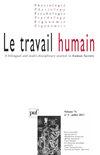Évaluation des pratiques de diagnostic de stress au sein d'entreprises belges : facteurs bloquants et facteurs stimulants
IF 0.5
4区 管理学
Q4 ENGINEERING, INDUSTRIAL
引用次数: 17
Abstract
Over the last decade, stress at work has become a major problem in Europe. A European and national legal framework has been developed and several methods for stress diagnosis and stress management intervention have been identified. Within this context, it is necessary to carry out a systematic examination of diagnosis practices and interventions that take place in companies. The objectives of the study were : 1 / the evaluation of work stress diagnosis practices in Belgian companies, and 2 / the identification of factors that stimulate or block the implementation of stress management interventions. A survey was used to collect data about work stress diagnosis practices. The first objective was explored through qualitative open questions about stress diagnosis and intervention. The second objective was achieved using a specific questionnaire, which was elaborated for the purpose of the study. Based on a review of the scientific literature, this questionnaire assessed the stimulating and blocking factors for implementing stress management interventions. The sample includes 180 Belgian companies of different sizes (from 20 to more than 10,000 workers) and from different sectors of activity. Only one out of six companies had implemented a stress diagnosis. Among those who had done so, only one out of two had implemented actions, and only one out of four had moved onto an evaluation stage. Stimulating factors related to the methodology implemented and the communication process were identified, as well as blocking factors relating to financial and temporal constraints, and the context of change in the company. The latter is a relatively new factor with regard to the existing literature. The discussion includes four points of analysis. The interventions which are implemented are clearly concerned with the primary approach that focuses on the work environment. Secondly, the results support the necessity for a systematic evaluation process of stress management interventions. Moreover, the results offer evidence of a need for sensitisation and publication of best practices about the necessary stages in the stress prevention process, as well as about stimulating and blocking factors. This holds especially true for small-size companies which carry out fewer diagnoses than larger ones. It is also important for companies which are not yet involved in stress diagnosis, and those that are less aware of the impact of financial and temporal constraints.比利时公司压力诊断实践的评估:阻碍因素和刺激因素
在过去的十年里,工作压力已经成为欧洲的一个主要问题。已经制定了欧洲和国家法律框架,并确定了几种压力诊断和压力管理干预方法。在这种情况下,有必要对公司的诊断实践和干预措施进行系统检查。本研究的目的是:1 /评估比利时公司的工作压力诊断实践;2 /确定刺激或阻碍压力管理干预措施实施的因素。通过调查收集有关工作压力诊断实践的数据。第一个目标是通过关于压力诊断和干预的定性开放问题来探索。第二个目标是通过一份具体的调查问卷实现的,该调查问卷是为本研究的目的而精心设计的。在回顾科学文献的基础上,本问卷评估了实施压力管理干预的刺激和阻碍因素。样本包括180家不同规模的比利时公司(从20人到1万多人),来自不同的活动领域。只有六分之一的公司实施了压力诊断。在这样做的国家中,只有二分之一的国家执行了行动,只有四分之一的国家进入了评价阶段。确定了与实施方法和沟通过程相关的激励因素,以及与财务和时间限制以及公司变化背景相关的阻碍因素。相对于现有文献,后者是一个相对较新的因素。讨论包括四个分析点。所实施的干预措施显然与以工作环境为重点的主要办法有关。其次,研究结果支持对压力管理干预措施进行系统评估的必要性。此外,研究结果提供了证据,表明需要对压力预防过程的必要阶段以及刺激和阻断因素进行敏感化和公布最佳实践。这一点尤其适用于比大公司进行更少诊断的小公司。对于那些尚未参与压力诊断的公司,以及那些不太了解财务和时间限制影响的公司来说,这也很重要。
本文章由计算机程序翻译,如有差异,请以英文原文为准。
求助全文
约1分钟内获得全文
求助全文
来源期刊

Travail Humain
管理科学-工程:工业
CiteScore
1.20
自引率
14.30%
发文量
6
审稿时长
>12 weeks
期刊介绍:
Le Travail humain est une revue scientifique pluri-disciplinaire qui publie des articles originaux en français ou en anglais, pertinents à l"étude de l"activité au travail, plus particulièrement dans les domaines suivants :
- physiologie et psycho-physiologie ergonomiques (y compris les neurosciences, l"anthropométrie et la biomécanique)
- psychologie ergonomique (en intégrant les approches différentielles)
- formation (de l"étude des mécanismes d’apprentissage à la gestion des formations et à l"étude des qualifications)
- psycho-sociologie du travail et des organisations
- sécurité et fiabilité humaine
- psycho-pathologie du travail
- ergonomie et méthodologie
 求助内容:
求助内容: 应助结果提醒方式:
应助结果提醒方式:


